“I’m poisoned! Where’s the antidote?”
“Should have worn the rogue set like I told you.”
“Where’s my antidote! Bell, earth vessel, daggers, there it is.., and I’m dead.”
“Wait, I think I can kill it, and get back your salt. No, nonono!”
“Huhh, you survived that fall?”
“Apparently. But where am I?”
“It’s like a meadow. How peaceful.”
“Is that a unicorn? I’m going to pet the unicorn.”
“Don’t pet the unicorn.”
“I’m going to pet the unicorn.”
The screen goes black. A complex symbol appears, you can’t help but think of the name of the game. Salt. Is that symbol perhaps drawn with salt? What does it stand for? Intrigued, you choose New Game. You scroll through the appearance choices, unaware if your gender, place of origin, skin colour, and hairstyle will have an actual impact on the game or not. You choose a class. You hover over the Chef option for a while, consider the Pauper, but ultimately opt for the Knight. And finally, choose the starting items. None of them mean anything to you, you pick one randomly.
The game starts.
You are on a ship, disoriented, a huge storm is raging on the sea. There is a terrible danger, says an NPC, you need to save the princess. Who is she? And where is she? No time to discuss, a figure dressed in black jumps over the sailor and quickly deals with him. He turns to you, and you grab your starting weapon. (Which may or may not be a cooking pan, but don’t be fooled, this is a serious game through and through.) You vanquish your foe, and start fighting your way through half a dozen marauders boarding the ship. You reach the deck, and the boss music kicks off. A gigantic monstrosity appears. It’s the Unspeakable Deep, declares the title, you draw your weapon, and charge…
Eventually, you wake up on a foggy, ethereal shore. You don’t remember anything, you only have the sense of an important mission. An old man greets you, and demands that you declare your loyalty to one of the three creeds he has heard of. Reluctantly, and without any information to support your decision, you obey. Shortly after your weird discussion with the man, you arrive at a certain place with magical ambience. You claim it for your chosen deity, and from that point, it will be your sanctuary. You grip your weapon, and venture forward into the vast unknown.
Welcome to the world of Salt and Sanctuary!

Salt and Sanctuary is a 2D RPG / hack and slash / platformer / let’s just quickly get this out of the way, soulslike – a genre describing games that resemble the generational masterpiece that is Dark Souls. Souls are salt now, bonfire is sanctuary, estus flask is refillable potion, blacksmithing, inventory, stat system, encumbrance is very similar, the list goes on. Now that it’s out of our system, I’ll try not to mention it too much.
In the game, your mission is basically to kill everything that moves, try to avoid most of the things that don’t move but still try to kill you, and explore the mysterious island you were washed up on. Apart from this quick summary, the story is anyone’s guess. The base of your operation will be the chain of sanctuaries you unlock, one by one. These are your safe places, your havens in this vast mazelike ocean (?) of a hostile world. You arrive at a sanctuary, claim it to your creed, have a rest, refill your potions, and try to find the next one before you eventually perish.
As you kill enemies, you gather their salt, which is basically the lifeforce in this world. You spend salt on levelling up your character and upgrading your weapons. If you die, you lose all the salt you haven’t spent yet, and mysterious figures will drag your body back to the most recent sanctuary you visited. However, if you rest at a sanctuary, all the enemies will respawn. There is an in-game explanation for this, you or the inhabitants of the island can’t truly die. It leads to some interesting decisions, like should you risk going forward if you are low on stats, or just return to your sanctuary, level up, but fight through the same enemies again.

The equipment is mostly what you would expect from a medieval fantasy game, you can use swords, axes, daggers, shields, huge two-handed weapons, bows, crossbows, there are also pistols, or you can also rely on magic. Equip a light armor and you probably get some nifty magical defenses but the first direct blow will kill you, or dress in a heavy body armor and see your movement speed dwindle down to snail pace. During the game, you will find different, but not outright better gear. Keeping your starting equipment and upgrading them and never using anything else is a perfectly viable option in this game, in fact I just did that with my starting armor.
As you progress, you can also upgrade your sanctuaries by hiring various service providers, the blacksmith upgrades your weapons, you can buy stuff at the merchant, others teach you spells and prayers, provide a sellsword (hello, co-op mechanism!), transmute your weapons into powerful unique magical ones, or, most importantly, teleport you to another sanctuary. The services you can get at a sanctuary all depend on your chosen creed, for example, one god may have merchants that sell various heavy weapons, others have merchants that provide high-level spells. You can also betray your creed and fight the loyalists and enter different creeds, it’s a very intricate system way beyond the scopes of this review so this is where I’m going to stop.
One of the features I found very unique in Salt and Sanctuary is how the 2D map is one huge continuous area. There are no loading screens, no distractions, no cutscenes, which is quite an amazing feature. It’s always the same map, mind you, so no procedurally generated pointless nonsense, the whole thing is intricately planned, but it’s the same on all playthroughs.
Oh and you can do the whole thing with a buddy. You control two different characters, and explore the island and fight the monsters and save (?) the princess (?) together.
The Good
Salt and Sanctuary is incredibly addictive, at least for us. It might be a bit weird putting this on top of the good list, but you could say I have an addiction for addictive games, and I really seldom experience this level of “Just One More Run Syndrome”. The real question is why the game is so addictive, so let’s try to dissect it.
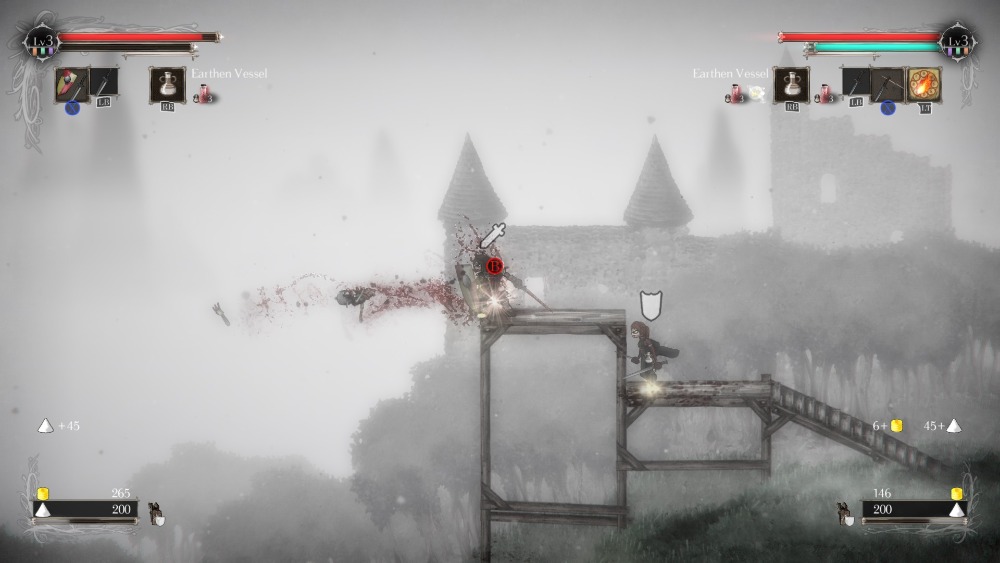
First of all, the challenge level is well measured. The enemies’ level do not change with yours, they have fix stats. By the end of the game, you are at least 10 times more powerful than when you started, and yet in this vast explorable world, you somehow always roughly keep to your level of enemies. We very rarely managed to waltz through an area, and conversely, very rarely felt that it’s hopeless and we need to engage in some mindless grinding to stand a chance.
The atmosphere is amazing, the stoner rock music, de-saturated artwork, level design, all work together to create this notion of a living, eerie, very much hostile world, packed with things to kill you. It is really you against the world, leaving the safe sanctuary and poking your head in the dark tunnel where you can hardly see but can hear wings flapping in the air and it’s like some huge shape over at the side of the screen – it does evoke strong emotions in me. It’s not outright scary, but it definitely is chilling and unsettling, especially if you are playing alone. This is one area where the co-op experience cannot grow up to the solo play, but the horror feeling is still there, it just probably won’t take the dreaded existential angles…
Most of the bosses also look cool, but there are a couple where the 2D style does not really manage to convey depth, so their little flying companions look like they are cut out of paper. Bosses are usually very much grounded, so large beasts, things consisting of things that should be on different type of things, or large men with weapons, what I’m trying to say is that there is no giant floating head that spits out other smaller heads that go around in a circle. This gives a game a very much appreciated realistic look, (I mean considering the setting), but does limit what each boss can do in 2D.
Enemy design is great, we mentioned it a couple of times before in other reviews how dull it can be when you finish a game and you can’t recall a single enemy type. It’s the exact opposite here, virtually all the enemies have their own unique thing, and I’m confident I could tell you what at least 80% of them do. You know what, I looked up the bestiary, and yes, I could list what most of them do, and there are almost a hundred different enemies in the game. You have your beast dogs that jump and suppress, the giant axe throwing dudes, the knights on horsebacks, unicorns that impale, trolls that belch, giant eyeballs that make all the other enemies immune to damage, invisible stuff, flying stuff, giant stuff. Don’t forget the blobs that drop on you and immediately start the digesting process like an impatient and rude dinner guest. They all have a place in the game, and you need to figure out the optimal way of fighting them. Hell, even the lowest level drowned ghouls in the first chapter are threatening in their own way, they jump-slash, emerge from the ground, and if you are not careful, a handful of them can easily tear you apart, no matter what level you are.
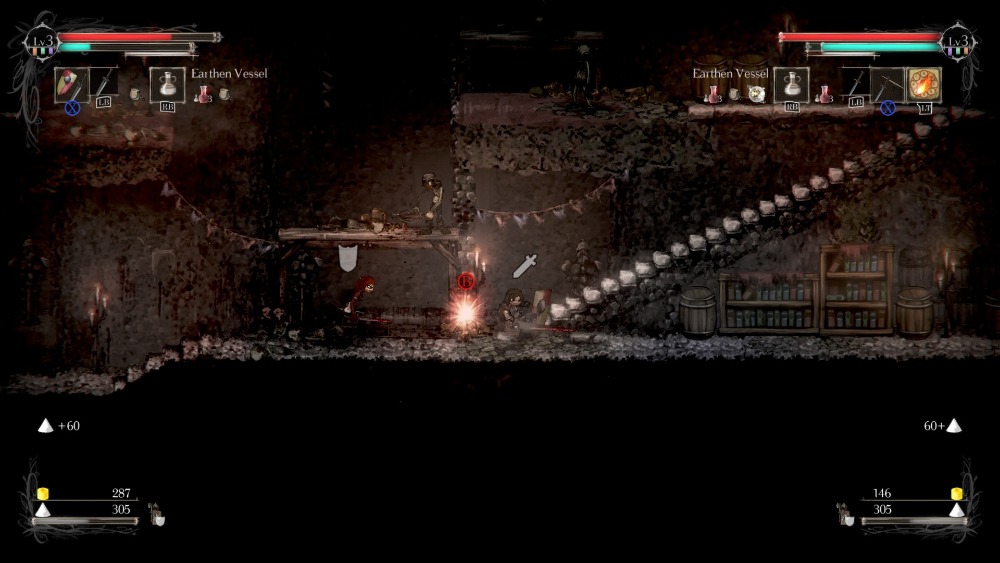
I mentioned the huge, continuous map before, and would like to dwell on that feature a bit more to make sure the message goes through. So the way it works, you enter a castle, only to realize there are hidden catacombs under it, which lead you to an enchanted forest, down to some caverns (filled with scores of enemies and traps, and it takes an hour to get through all this, mind you), only to climb up a veeery long ladder and arrive at a closed door, you open it, and oh my god, that was the door that was locked five hours ago and you could not open from the other side and you are back and there is the first sanctuary and now it’s going to take only like half a minute to get back! Finding these shortcuts, opening a gate or kicking down a ladder so you can get back to familiar territory after a long series of frantically jumping through enemies because you are out of healing potion is incredibly satisfying. (Although my partner in crime now wants me to mention that not all the secret shortcuts are satisfying to open to which I can only say that NOt aLl tHe SecREt sHorTCutS ArE SatIsfyiNg tO oPEn.)
If you are anything like me, you will start drawing a map at some point. And I mean how cool is that! An actual hand-drawn map to a game, like in the 90’s! You will mess up the proportions of course so when two areas get connected through a secret shortcut you will need to arrow stuff together. And once you finish the game, you can google the actual map, and be astonished by the density and how these different areas like the jumpy bit and the one with the swamp are all intimately connected. There is no cheating either, so if there has to be a long corridor that takes half a minute to walk through, it will be there. That can be mildly annoying, but this brings me to my next point.
The game has annoying bits, and I like that. I know I start to sound like a delusional and not-so-trustworthy source of information, so hear me out. Every great game needs a bit that you hate. The one that you can hardly wait to be over and then you can discuss how terrible it was. Even Diablo II (praised it be) has an Act III jungle. You do need that, otherwise you could not fully appreciate the part of the game that’s not terrible. In Salt and Sanctuary, there is a huge section around the end where you are just dropping down from one tiny platform to the other, it’s kinda unimaginative, and there are ledge triple jumps to perform in the air and if you miss it you drop to your death. It takes five minutes to get there from the nearest sanctuary, you have one chance, if you miss you die, and if that is not annoying, I don’t know what is. So, good, the game even has that.
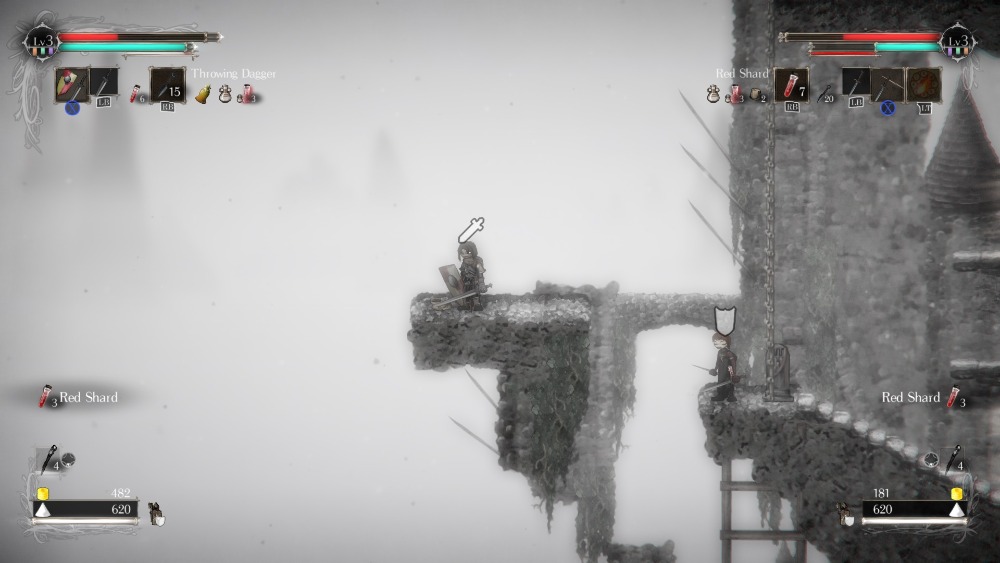
Kinda similar point, there are a number of half bug half feature occurences. There are enemies that you can cheese by standing close to corners and you can reach them but their limited A.I. can’t reach you. Or sometimes you can survive huge drops I’m not sure you were supposed to survive so you can skip an area and open the long-awaited shortcut. I think this gives a game a gamey feel, something you can play with, something you can explore and break its rules. I like it when not everything is clear-cut and follows a well-scripted fix story and behavior, because that is when a lot of the gaming magic happens. Assuming it’s done in moderation of course.
There are various playstyles at your disposal (considering the primary game mechanic is basically a humble 2D platformer), you can go as a melee brute, a finessed duelist, archer or a pistol user, a mage, or any combination of them. The co-op experience is very much different from the solo play in this regard, for example going for the non-viable glass cannon mage becomes an option if you have a trusty tank partner.
The skill tree is very elegant. There are no fix classes in the game, instead, you have your six attributes (strength, endurance, dexterity, willpower, wisdom, magic), and your weapon proficiencies (for example, you need to learn to use the level 3 whips), and that collection of attributes and proficiencies defines your character. Each weapon / armor / shield type that you can learn is connected to an attribute, so for example if you learn to use the level 4 greathammers, you also get 4 strength points. Now, you can only select skill points that are connected to another point in the tree that you already have, meaning in order to branch out to another area, you have to slowly make your progress towards it. For example, in the picture below, the mage’s starting skills are colored, and the swirly pattern in the bottom left corner is the mage stuff. That’s where you have your potions and magic power and spell level and wands and staff. Greathammers are in the upper right corner. One starting as a mage could go there, sure, but should one? The answer is probably not.

You probably realize it at this point, it’s a fairly involved game, I would say more complicated than your average ARPG. There is a ton of small things going on, all your equipment has seven levels to upgrade with various stuff only certain enemies drop, you have your huge selection of rings, charms, prayers, disposable items to use, you takejobs for your chosen creed to improve your devotion level which means you have access to better gear at the shops and that selection all depends on the creed of course.Not to mention all the secrets. I’m talking equipping a certain piece of equipment but not before completely arbitrarily using a consumable item at a certain place before talking to an NPC in order to get the dialogue option or dropping down at certain cliffs to find the secret Order of the Betrayer that you can only enter if you did some specific things beforehand. I always find it weird in games, to have features that no common mortal would figure out on their own, but I’m actually glad they are there, the sense of not knowing everything gives much depth to this made-up world. Heck, there are secrets in the skill tree menu!
And finally, to close it off with a very subjective matter, I like how the game is full of tiny details. There are candles lit before every boss, a certain number of them, and during the whole game, we tried to find the pattern in it, hanged people sometimes appear on gallows, there are tombstones marking the untimely deaths of other adventurers. There is also the usual system of leaving notes for other players who are in the game around that time, which works surprisingly well in the setting.
The Bad
Here we go, with bleeding heart, I have to admit, Salt and Sanctuary has its fair share of issues, and it can be outright frustrating at times (not in the good way!).
A lot of the mechanics are clunky. You get to keep all the weapons you ever received with you, and only the equipped ones are counting towards the equipment load. That is great, you don’t have to run back and forth to a stash. Yes, sounds great, but once you get 15 armor sets with your helmet & armor & gloves & pants it gets really tiring to keep changing them just because you run into a fire monster and you need your fire protective gear. Selecting items for upgrades is also slow and annoying. Same with exchanging rings, you quickly acquire a sizable collection of the little buggers, but they don’t have nuance. There is one fire defense ring in the game, so you put it on when fighting a difficult fire-related adversary, and you take it off afterwards, scroll through your collection again to put on the right one… It’s very algorithmic, a required repetitive action, hence not a challenge, but an annoyance. Changing armor is also a chore, when you hover over a new piece you consider equipping, the game tells you if the new stats would be lower or higher than the current ones, but not the difference, or a handy table of before-after stats so you have to memorize the stats. There is no quick back and forth switching either, because, remember, a hundred armor items in your inventory.
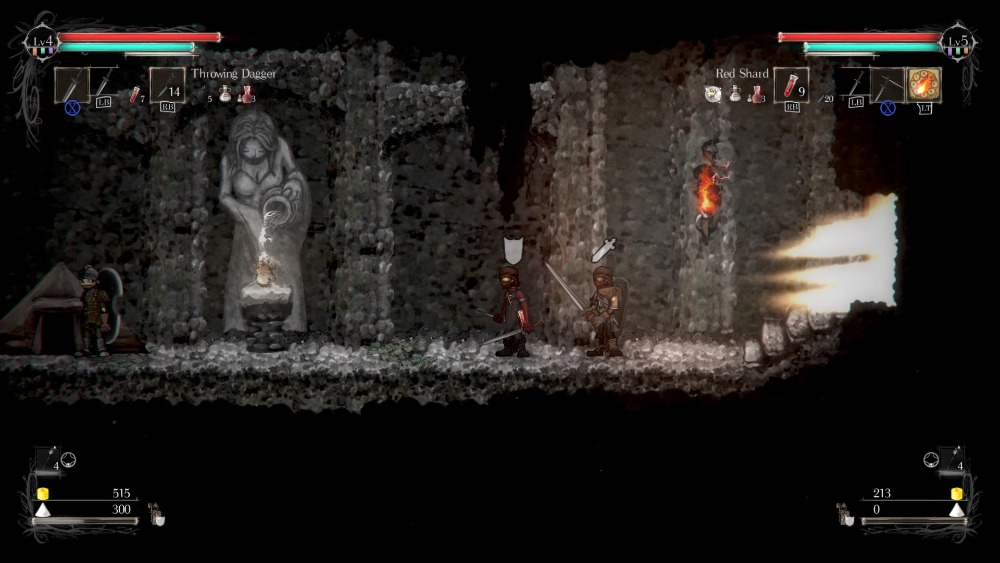
Co-op has its own share of clunkiness. The game is shared screen, which is great, but there’s nothing stopping you from walking the opposite direction, other than consideration towards the other player. The screen zooms out for a while, and then gives up, and focuses on the main player. That is all fine and good as long as you are casually walking on a moonlit beach, but once you have to jump through miles of collapsing platforms with very intricate timing so you either have to do it perfectly together or one player has to do it blind… well that puts a tension on even the strongest relationships! On the plus side, if you are too far away, if one player goes in the inventory, they will be teleported to the other one immediately. Handy, but weird, and very much abusable.
I mentioned before that the bosses look great, but if you were paying attention, you might have noticed that I never said they are great in general. Mechanically, most of the bosses are dull and samey. That is mostly due to 2D limitations, they jump, slash, do magic attacks, but that’s it. There are huge bosses taking up half the screen, and in that situation, you don’t even try to see the attack patterns or roll, you just hack at the beast, and hope that your armor will hold up by the time you are through. Bosses also tend to be somewhat easy. A fair share of them we just walked in on and killed without much effort. In fact, the most difficult boss we encountered was an optional one, and then it dropped exactly zero experience points. Also, there is almost always a shrine just next to the boss. Which is nice, sure, but still. Casual much?
Some people (khm) might also find it difficult to navigate in the game. The map is purposefully disorienting, and there is a fair amount of backtracking (“I’m sure it’s here, it’s on the top of the stairs, come on, almost there, oh, no, we are in a totally different are than I thought”). Well, you either love it or hate it.

One thing that’s objectively questionable though, there is literally no story, you are looking for a princess and that’s it. Yes, I do understand the concept, show don’t tell, ye ye, but this brings Soulslike storytelling to a whole new unwanted level of minimalistic. I do try to pay attention to the story in games, and generally tend to be drawn towards games with good stories and background and worldbuilding. There is nothing here, that princess bit is honestly the only thing I understood. Well I guess I also noticed how weirdly the map is meshed together, and it actually has an in-game explanation, it’s just very much hidden. Someone on reddit made a 87-page long pdf of the lore (it’s called The Drowned Tome, check it out, it is mesmerizing), based on item description, NPC gibberish, bestiary entries, and, wait for it, skill tree quotes. Yes, in the skill tree, every point has a quote, if you read them in a correct order, you get a story. I love that it’s there, great, it does tingle my mystery-sense. But I would prefer some parts of it to be more direct. You don’t have to spell anything out, just give me some random puzzle pieces I can’t miss, because as of now, there’s nothing to start on now. And the game is not big enough for story to ooze in through set pieces and gameplay like in the big daddy that is Dark Souls. You are not talking to NPCs, they don’t fight with you, there is no large bell-ringing moment, you make progress and kill things and occasionally open a door. If you read the lore background, you realize there is an incredible amount of information here, for example, even the starting locations you pick at the very beginning have a place in the story, there is an explanation on why one specific boss does not drop salt, all the NPCs’ backstory is explored, it’s all there… it’s just a shame you have to look elsewhere to get any of it. It’s like painting a masterpiece and then covering it up with white paint.
And while we are in the Soulslike territory, a number of mechanisms are quite counterintuitive. I know we can’t have tutorials because we are hardcore, but some of these are really weird to wrap your head around. The best example is the stamina bar. During the game, we were exposed to notions like stamina and fatigue and focus and willpower, and they all do something with the stamina bar, after a while another little bar gets filled up from the back with red, and it’s somehow the same for magic and physical stuff but works differently, and I know what you are thinking, duh, you get tired after a while and have to rest, but take my word for it this one time, it is really confusing. We read the wiki entry and were not one bit smarter after we did that.
The Co-Op
So, getting the co-op started is a bit of a puzzle in itself, and in fact I played through the game once, and never realized it’s there. You have to have a save file for both of you, and then one of you have to pick the stone sellsword as the starting item, go until the first sanctuary, and summon the other player. It’s just an about five minutes of hassle, but it is a hassle nevertheless. When you quit the game, you have to summon the other player at a sanctuary again, and that sanctuary has to have a sellsword merchant.
And while we are at it, there is a main player, and a lowly sellsword player – meaning the two of you are not equal. Only main players can get devotion, upgrade sanctuaries, upgrade refillable potions, collect certain crafting items, and as a result upgrade weapons to the highest level (this is not as big of a deal as you might think), and, wait for it, only main players can open doors without adult supervision. Sellswords players can also go in their own save file and quickly upgrade stuff if they want, but it’s clunky, and not justified from a story perspective.
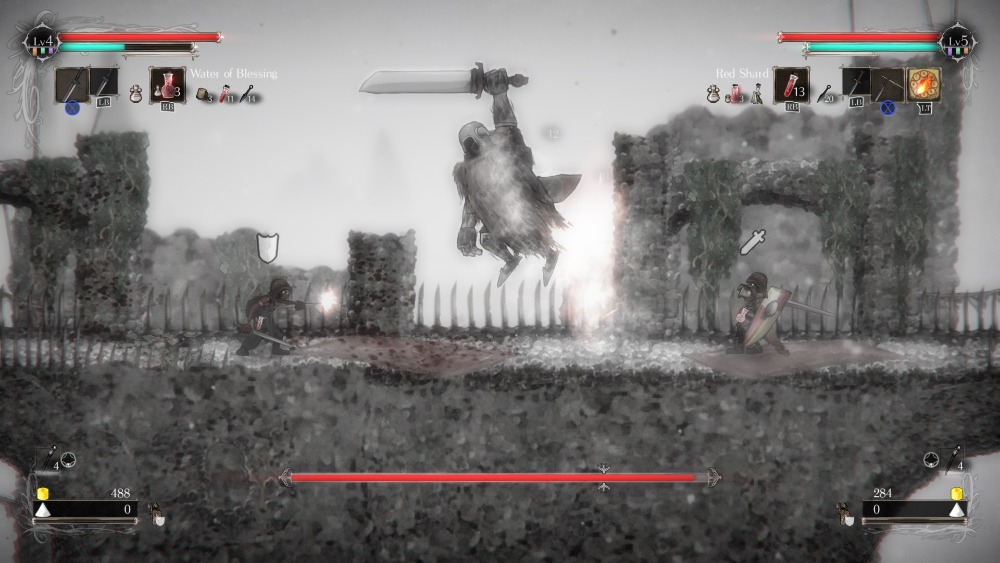
Oh, and this is important information, you can’t play online. You physically have to be at the same computer / console. We personally really liked that, but it definitely is a limitation.
Those put aside, co-op is great, we are having a blast. Figuring out where to go next, combining different playstyles, coming up with strategies against bosses, even the occasional grinding is fun and engaging. The game is surreal and nightmarish enough that another human player does not really make it weird.
If one of you dies, the other can get back the dropped salt and return to the closest sanctuary to revive the dead person. Well, meet them there, because the mysterious people already took care of that.
The interesting bit is how different the co-op experience is from solo play, and yet both are enjoyable. It’s like an anti Stardew Valley. The game is much easier with two players, even though the monsters are supposed to scale. We actually liked it, it would be incredibly frustrating to wipe for 10+ times on the same boss, like you sometimes do in challenging soulslike games.
The Recommendation
The best way to position Salt and Sanctuary is that it’s a snack-sized Dark Souls you can play with a partner. So if you liked those games, or wanted to try but was too much for you, I would definitely give it a go.
The game is fairly complex, but the difficulty is not that daunting. Definitely recommended for more seasoned players, and definitely not for beginners. You also have to be somewhat skilled to beat the game, you can’t just grind your way through, there is an element of the good old “git gud”. The theme is very strong, so check out a gameplay video, and I’m pretty sure the decision would be easy afterwards.
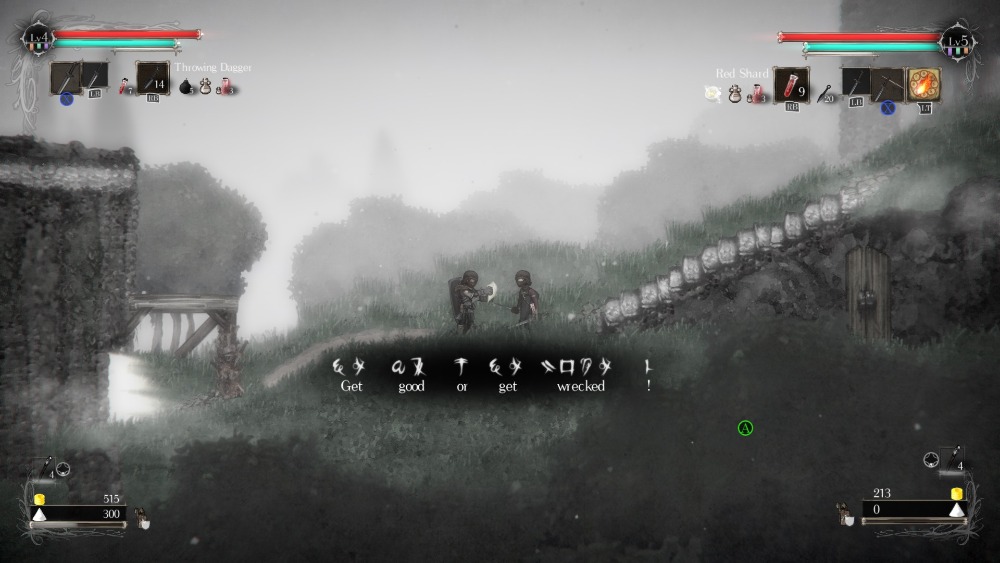
Salt and Sanctuary is one of those rare cases where a single player atmosphere transports very well to co-op, it was an amazing and unique experience. Can’t wait for our next playthrough! I swear I won’t be a strength two-handed greataxe guy this time.
Info
| Release Year | 2016 |
| Genre | Platformer |
| Difficulty | Hard |
| Number of Players | 1 to 2 |
| Length | 20 hours |
Rating
| Overall | Amazing |
| Story | Mediocre |
| Co-Operation | Good |
(Editor note: since writing this review, we did the second playthrough, and I’m proud to announce that I was not a strength two-handed greataxe guy! I was a dexterity one-hand sword and pistol guy. Who spent every living second wishing he were a strength two-handed greataxe guy, his damage was so measly!)